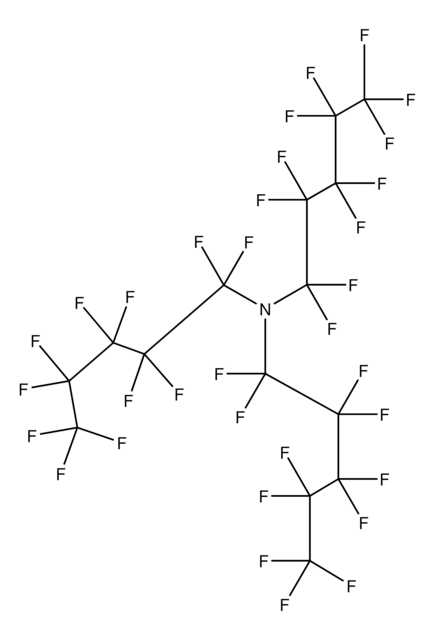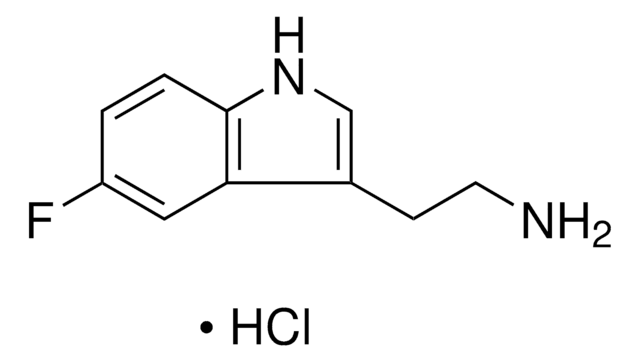F9755
Fluorinert™ FC-40
immiscible fluorocarbon oil
Synonym(s):
immiscible fluorocarbon oil
Sign Into View Organizational & Contract Pricing
All Photos(1)
About This Item
Recommended Products
Quality Level
form
liquid
density
1.85 g/mL at 25 °C (lit.)
application(s)
hematology
histology
InChI
1S/C10F22/c11-1(12,3(15,16)5(19,20)7(23,24)9(27,28)29)2(13,14)4(17,18)6(21,22)8(25,26)10(30,31)32
InChI key
BPHQIXJDBIHMLT-UHFFFAOYSA-N
General description
Fluorinert™ FC-40 is a clear, colorless, non-conductive, and non-flammable liquid that is part of the Fluorinert™ family of products manufactured by 3M. It is a perfluorinated fluid that has excellent thermal and chemical stability and has a high electric strength, making it suitable for use as a heat transfer fluid. Fluorinert™ FC-40 has a low boiling point (about 155 °C)It is an immiscible fluorocarbon oil.
Application
Fluorinert™ FC-40 has been used to evaluate its compatibility with real time quantitative PCR. It has been used in the cytoskeletal contractility assay to deposit samples in dish.
For possible use as a high density chase solution in density gradient studies.
Packaging
Packaged and distributed by Sigma-Aldrich
Other Notes
A trademark for a liquid mixture of completely fluorinated aliphatic compounds.
Legal Information
Fluorinert is a trademark of 3M Company
Storage Class Code
10 - Combustible liquids
WGK
WGK 2
Flash Point(F)
Not applicable
Flash Point(C)
Not applicable
Personal Protective Equipment
dust mask type N95 (US), Eyeshields, Gloves
Certificates of Analysis (COA)
Search for Certificates of Analysis (COA) by entering the products Lot/Batch Number. Lot and Batch Numbers can be found on a product’s label following the words ‘Lot’ or ‘Batch’.
Already Own This Product?
Find documentation for the products that you have recently purchased in the Document Library.
Dielectrophoretic characterization of cells in a stationary nanoliter droplet array with generated chemical gradients.
Ben-Arye T et al.
Biomedical Microdevices, 17, 91-91 (2015)
Senne Cornelis et al.
Scientific reports, 9(1), 7341-7341 (2019-05-16)
The demand to perform forensic DNA profiling outside of centralized laboratories and on the crime scene is increasing. Several criminal investigations would benefit tremendously from having DNA based information available in the first hours rather than days or weeks. However
A quantitative analysis of contractility in active cytoskeletal protein networks.
Bendix PM, et al.
Biophysical Journal, 94, 3126-3126 (2008)
Influence of segmenting fluids on efficiency, crossing point and fluorescence level in real time quantitative PCR.
Walsh EJ et al.
Biomedical Microdevices, 8, 59-59 (2006)
Patrick S Stumpf et al.
Communications biology, 3(1), 736-736 (2020-12-06)
Biomedical research often involves conducting experiments on model organisms in the anticipation that the biology learnt will transfer to humans. Previous comparative studies of mouse and human tissues were limited by the use of bulk-cell material. Here we show that
Our team of scientists has experience in all areas of research including Life Science, Material Science, Chemical Synthesis, Chromatography, Analytical and many others.
Contact Technical Service





![Poly[4,5-difluoro-2,2-bis(trifluoromethyl)-1,3-dioxole-co-tetrafluoroethylene] dioxole 87 mol %](/deepweb/assets/sigmaaldrich/product/structures/951/320/21327fcd-4960-402d-8ae1-bf2e379cb2e2/640/21327fcd-4960-402d-8ae1-bf2e379cb2e2.png)


